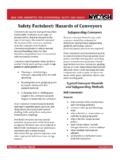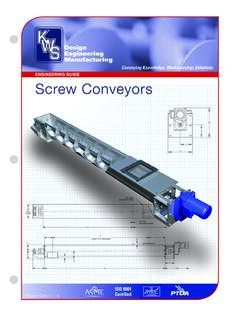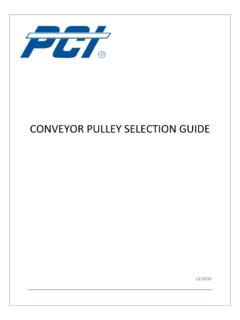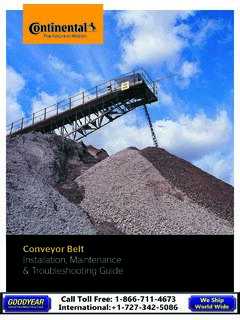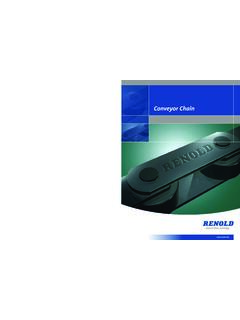Transcription of FACT SHEET OSHA Safety Materials Handling, Storage & Use
1 FACT SHEET . osha Safety Materials handling , Storage & Use In the case of Materials handling , Storage , use and disposal, remember that the main hazards are injuries from: Improper manual lifting or carrying loads that are too heavy, large or unwieldy Being struck by Materials or being caught in pinch points Being crushed by machines, falling Materials or improperly stored Materials Incorrectly cutting ties or securing devices Manual Materials handling (lifting, carrying, pushing, pulling) is the most common category of compensable injuries in the United States work force, with four out of five of those injuries involving the lower back.
2 osha recommends using a formal training program to reduce Materials handling hazards. The content of the training should emphasize factors that will contribute to reducing workplace hazards, including: Alerting the employee to the dangers of lifting without proper training. Showing the employee how to avoid unnecessary physical stress and strain. Teaching workers to become aware of what they can comfortably handle without undue strain. Instructing workers on the proper use of equipment. Teaching workers to recognize potential hazards and how to prevent or correct them.
3 A training program to teach proper lifting techniques should cover the following topics: Awareness of the health risks to improper lifting citing organizational case histories Knowledge of the basic anatomy of the spine, the muscles, and the joints of the trunk, and the contributions of intra-abdominal pressure while lifting Awareness of individual body strengths and weaknesses determining one's own lifting capacity Recognition of the physical factors that might contribute to an accident, and how to avoid the unexpected Use of safe lifting postures and timing for smooth.
4 Easy lifting and the ability to minimize the load-moment effects Use of handling aids such as stages, platforms, or steps, trestles, shoulder pads, handles, and wheels Knowledge of body responses warning signals to be aware of when lifting To reduce potential accidents associated with workplace equipment, employees need to be trained in the proper use and limitations of the equipment they operate. This includes knowing how to effectively use equipment such as forklifts (also known as powered industrial trucks), earth-moving equipment, conveyors, cranes and slings. Safety precautions the user can observe when operating or maintaining any of these powered industrial trucks include: That high lift rider trucks be fitted with an overhead guard, unless operating conditions do not permit.
5 That fork trucks be equipped with a vertical load backrest extension according to manufacturers' specifications, if the load presents a hazard. That battery charging installations be located in areas designated for that purpose. That facilities be provided for flushing and neutralizing spilled electrolytes when changing or recharging a battery to prevent fires, to protect the charging apparatus from being damaged by the trucks, and to adequately ventilate fumes in the charging area from gassing batteries. That conveyor , overhead hoist, or equivalent Materials handling equipment be provided for handling batteries.
6 That auxiliary directional lighting be provided on the truck where general lighting is less than 2 lumens per square foot. That arms and legs not be placed between the uprights of the mast or outside the running lines of the truck. That brakes be set and wheel blocks or other adequate protection be in place to prevent movement of trucks, trailers, or railroad cars when using trucks to load or unload Materials onto train boxcars. That sufficient headroom be provided under overhead installations, lights, pipes, and sprinkler systems. That personnel on the loading platform have the means to shut off power to the truck.
7 That dock boards or bridge plates be properly secured, so they won't move when equipment moves over them. That only stable or safely arranged loads be handled, and caution be exercised when handling loads. That trucks whose electrical systems are in need of repair have the battery disconnected prior to such repairs. That replacement parts of any industrial truck be equivalent in Safety to the original ones. Storing and stacking Materials can be dangerous if workers do not follow Safety guidelines. Falling Materials and collapsing loads can crush or pin workers, causing everything from minor injuries to death.
8 In order to help prevent injuries when stacking Materials , workers must do the following: Observe height limitations; for instance, stack lumber no more than 16 feet high if it is handled manually, and no more than 20 feet if using a forklift;. Remove all nails from used lumber before stacking;. Stack and level lumber on solidly supported bracing;. Ensure that stacks are stable and self-supporting;. Do not store pipes and bars in racks that face main aisles to avoid creating a hazard to passersby when removing supplies;. Stack bags and bundles in interlocking rows to keep them secure; and Stack bagged material by stepping back the layers and cross-keying the bags at least every ten layers (to remove bags from the stack, start from the top row first).
9 During Materials stacking activities, workers must also do the following: Store baled paper and rags inside a building no closer than 18 inches to the walls, partitions, or sprinkler heads;. Band boxed Materials or secure them with cross-ties or shrink plastic fiber;. Stack drums, barrels, and kegs symmetrically;. Block the bottom tiers of drums, barrels, and kegs to keep them from rolling if stored on their sides;. Place planks, sheets of plywood dunnage, or pallets between each tier of drums, barrels, and kegs to make a firm, flat, stacking surface when stacking on end.
10 Chock the bottom tier of drums, barrels, and kegs on each side to prevent shifting in either direction when stacking two or more tiers high; and Stack and block poles as well as structural steel, bar stock, and other cylindrical Materials to prevent spreading or tilting unless they are in racks. osha recommends that employers establish a formal training program to teach workers how to recognize and avoid Materials handling hazards. Instructors should be well-versed in Safety engineering and Materials handling and storing. The training should reduce workplace hazards by emphasizing the following factors: Dangers of lifting without proper training Avoidance of unnecessary physical stress and strain Awareness of what a worker can comfortably handle without undue strain Proper use of equipment Recognition of potential hazards and how to prevent or correct them
